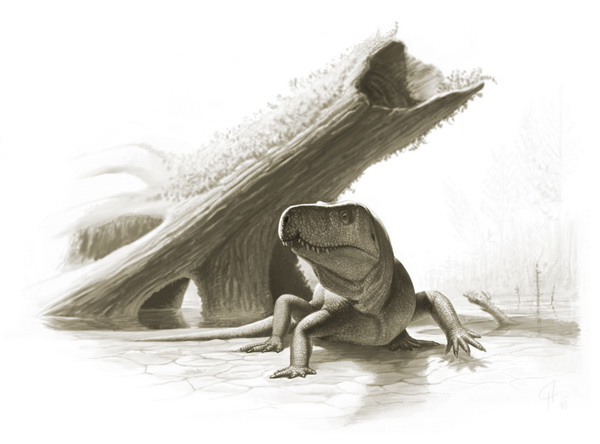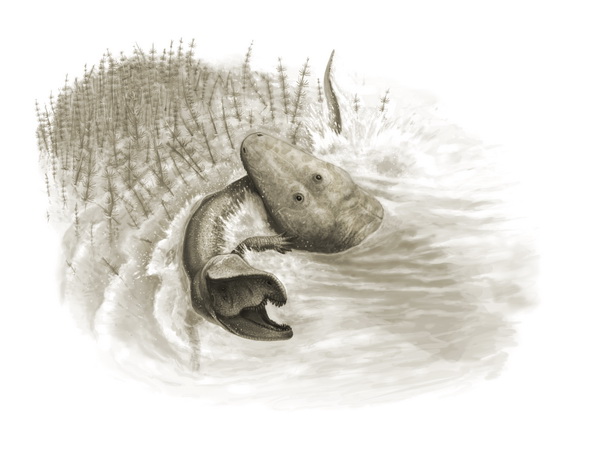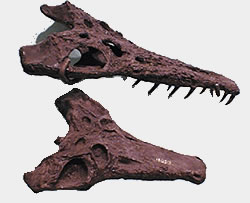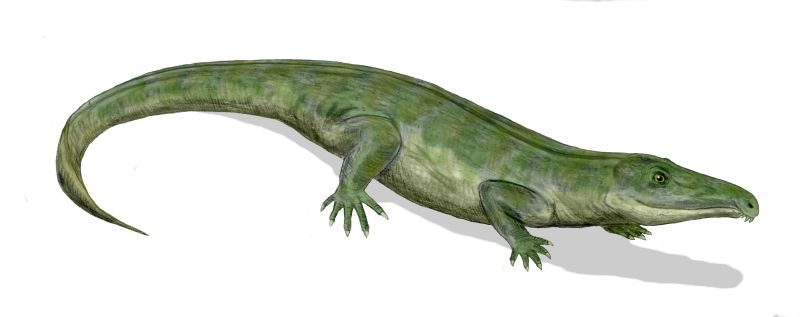[Recent Entries][Archive][Friends][User Info]
February 19th, 2012
| February 19th, 2012 | |
|---|---|
| 09:54 am [industrialterro] [Link] |
Garjainia Garjainia is an extinct genus of archosauromorph reptile. It was about 1.50–2 m (5–6 ft 8 in) long. Гаряиния (Garjainia) — из раннего триаса Восточной Европы. Род выделен В.Г. Очевым в 1958 году, назван в честь саратовского геолога В.А. Гаряинова. Один из самых примитивных представителей группы. Длина черепа более 60 см, общая длина до 3 - 4 метров. Происходит из оленекского яруса раннего триаса Оренбуржья и Башкирии. Два вида — G. prima и G. triplicostata. Второй вид долгое время выделялся в особый род Vjushkovia. Оба вида известны по достаточно полным остаткам, включая полные скелеты. В старых источниках гаряинию относили к роду Erythrosuchus. Гаряиния была крупнейшим хищником триасового Приуралья. Она принадлежала к семейству эритрозухий и приходилась близкой родственницей, практически прабабушкой крокодилам, динозаврам и птицам, появившимся на планете спустя миллионы лет. Самой примечательной ее особенностью был загнутый кончик рыла, который помогал удерживать пищу во рту. Он был похож на клюв, усеянный длинными мощными клыками. Гаряинии унаследовали его от своих рыбоядных предков. Гаряинии вырастали до четырех метров и должны были питаться крупными животными. Их родичи, африканские эритрозухи охотились на больших ящеров дицинодонтов. Логично предположить такое меню и для гаряиний. Однако в соответствующих слоях не найдено ни одной кости дицинодонтов. Они встречаются и в более поздних, и в более ранних отложениях, а во времена гаряиний парадоксальным образом отсутствуют. Почему – неизвестно. Скорее всего, гаряинии сидели на диете из рыб, амфибий-лабиринтодонтов и длинношеих «ящериц» пролацертилий (проторозавры). Об их водном образе жизни говорят и слабые конечности с хрупкими костями. В триасовых реках Приуралья плавали и другие великаны – амфибии паротозухи, достигавшие двух-, а то и трехметровой длины. Их глаза находились на самом верху черепа, поэтому паротозухи могли смотреть только вверх. С таким зрением нельзя гоняться за рыбой. Паротозухи были пассивными, засадными хищниками и подолгу лежали на дне, дожидаясь, когда поблизости появится добыча. Таких хищников называют «живыми капканами». И.А. Ефремов очень живописно написал про них в «Туманности Андромеды»: эта древняя саламандра с широким, плоским, как тарелка, черепом была обречена «лежать в теплой и темной воде болота, в ожидании, пока что-либо съедобное не приблизится на доступное расстояние. Тогда – быстрый рывок, широкая пасть захлопывалась и… снова бесконечно терпеливое, бессмысленное лежание». Крупные паротозухи легко могли утолить гастрономические потребности гаряиний. Но были и очень крупные, способные не только постоять за себя, но и напасть при случае на гаряинию. Схватки двух чудищ наверняка выглядели потрясающе. Трудно сказать, кто чаще оказывался победителем – грузные медлительные паротозухи или более быстрые, но хрупкие ящеры. Неслучайно на костях гаряиний имеется множество повреждений – у одной в двух местах сломана берцовая кость, у другой треснута нижняя челюсть, у третьей были разломаны и криво срослись шейные позвонки. Вряд ли гаряинии получили травмы во время охоты на рыб и «ящериц». По-видимому, эти следы оставили паротозухи. Других гигантов в тех местах не было… Правда, по берегам бродили еще одни хищные ящеры – яикозухи. От сотен тысяч этих рептилий, когда-то населявших Приуралье, сохранился всего один позвонок да бедренная кость. Судя по ним, яикозухи достигали двухметровой длины. Они питались относительно мелкой живностью и, скорее всего, избегали гаряиний. Точно так же почти не пересекаются дороги лисиц и волков, обитающих в одном лесу. Они добывают разных животных, используют разные охотничьи тактики и не воспринимают друг друга в качестве пищи…
Крупный старый паротозух атакует молодую гаряинию
Tags: Вымершие рептилии, Триас, архозавроморфы, диапсиды, эритрозухии |
| Time | Event |
| 10:34 am [industrialterro] [Link] |
Shansisuchus Shansisuchus (means 'crocodile from the Shansi Province') was an erythrosuchid, a type of carnivorous prehistoric reptile that lived some 220 million years ago during the middle Triassic Period in what is now Shansi Province in China. A meat eater, it belonged to the successful group of reptiles known as archosauromorphs, ancestors of the earliest true archosaurs. Although only 7.2 feet long and 1.6 feet tall, Shansisuchus was a fierce hunter with powerfully developed jaws. It is believed that it could move quite quickly for its size and fed on smaller, less agile reptiles around at the time. Шаньсизух (Shansisuchus)- из среднего триаса (анизий) Шаньси в Китае. Род описан Ян Чжунцзянем в 1964 году. Длина черепа до 60 см. Скелет относительно легкий, с длинными конечностями. Три вида.
Tags: Вымершие рептилии, Триас, архозавроморфы, диапсиды, эритрозухии |
| Time | Event |
| 11:27 am [industrialterro] [Link] |
Uralosaurus Уралозавр (Uralosaurus magnus) — из среднего триаса (донгуз, анизийский ярус) Оренбургской области. Известен по фрагментарным остаткам. Описан В.Г. Очевым как Erythrosuchus magnus в 1980 году, в особый род выделен А.Г. Сенниковым в 1995 году. Размеры огромные — череп до 70 см длиной. На нижней челюсти два передних зуба направлены вперед.
Tags: Вымершие рептилии, Триас, архозавроморфы, диапсиды, эритрозухии |
| Time | Event |
| 11:33 am [industrialterro] [Link] |
Chanaresuchus Chanaresuchus is an extinct genus of proterochampsian archosauriform. It was of modest size for a proterochampsian, being on average just over a meter in length. Fossils have been found from the Chañares Formation in La Rioja Provence, Argentina, dating back to the Ladinian stage of the Middle Triassic. Chanaresuchus appears to be one of the most common archosauriforms from the formation due to the abundance of specimens referred to the genus. Much of the material has been found by the La Plata-Harvard expedition of 1964-65. Chanaresuchus was originally classified in the family Proterochampsidae, although it has been placed in the family Rhadinosuchidae in more recent studies (both families belong to Proterochampsia). Chanaresuchus had a low, elongate skull that is characteristic of proterochampsians. The skull is quite broad posteriorly with a narrow snout, varying in length from around 165mm to 260mm in the largest individuals. The nares are slit-like and positioned away from the tip of the rostrum, farther up the skull. The premaxilla is slightly down-curved. The skull table is highly ornamented in larger specimens, with the dermal bones well sculptured. The palate of Chanaresuchus has two elongate choanae. Two small openings anterior to the choanae may be anterior palatine foramina that could have been used for access to vomeronasal organs. The secondary palate formed between these two sets of openings may have been an adaptation for breathing through the snout while underwater. Unlike other proterochampsians and early archosaurs, Chanaresuchus had little body armor. The only osteoderms found are small and scale-like, forming a single row down the neural spines. They run from the neck to the last presacral, and most likely continue on down the tail, although no specimens have been shown that suggest this. There are roughly three scales per vertebra. The foot of Chanaresuchus differs from other related archosaurs in that there is an emphasis on an enlargement of the inner phalanges, whereas other primitive archosaurs retain a somewhat more symmetrical pattern. The first digit is reduced but quite robust. The second digit is clearly the most massive, yet the third digit is the longest, although somewhat slender in comparison. The fourth digit is very slim and the fifth consists of only a metatarsal spur. A semiaquatic lifestyle similar to phytosaurs and modern day crocodilians has been proposed for Chanaresuchus, as is suggested by the secondary palate, dorsally facing orbits, dorsally positioned nostrils, and many other characteristics. However, some evidence, such as a lack of aquatic amphibians found from the Chañares Formation, suggests that the area was relatively dry during the time of deposition. A terrestrial lifestyle is possible for the genus, as extreme differences in the size of the forelimbs relative to the hind limbs in comparison to other "thecodonts" may be considered a characteristic of bipedalism. However, this is most likely not the case for Chanaresuchus, and the evidence still remains in favor of a semiaquatic animal. The depositional environment of the locality from which specimens of Chanaresuchus have been found was in close proximity to an area of high volcanic activity, due to the fact that it was in an active rift basin. It is thought that all of the recovered specimens had died in a single event of mass mortality and may have been buried on a fluvial strandline. The mortality-causing event was most likely linked to regional volcanic activity. Proterochampsia is a clade of early archosauriform reptiles from the Triassic period. It includes the genera Proterochampsa, Cerritosaurus, Chanaresuchus, Gualosuchus, Rhadinosuchus, and Tropidosuchus. Nesbitt (2011) defines Proterochampsia as a stem-based taxon that includes Proterochampsa and all forms more closely related to it than Euparkeria, Erythrosuchus, Passer domesticus (the House Sparrow), or Crocodylus niloticus (the Nile crocodile). Proterochampsians share several distinguishing characteristics, or synapomorphies. A prominent ridge runs along the length of the jugal, a bone below the eye. Another ridge is present on the quadratojugal, a bone positioned toward the back of the skull behind the jugal. There is also a depression on the squamosal bone of the skull roof. The second metatarsal of the foot is wider than the other metatarsals. Proterochampsians lack a fifth digit on the foot; the fifth metatarsal is reduced to a small pointed bone.
Tags: Вымершие рептилии, Триас, архозавроморфы, диапсиды, протерохампсии |
| Time | Event |
| 11:48 am [industrialterro] [Link] |
Proterochampsa Proterochampsa is a genus of proterosuchid archosauromorph from the Late Triassic of Argentina and Brazil (Paleorrota). Proterochampsidae is a family of archosauriforms. Proterochampsids may have filled an ecological niche similar to modern crocodiles, and had a general crocodile-like appearance. They lived in what is now South America in the Middle and Late Triassic. Proterochampsids have long, crocodile-like skulls. The posterior portion of the skull is wide while the snout is very narrow. Most proterochampsids also have downturned snouts. Like many early archosauriforms, they also have dermal armour. Proterochampsids have small holes called dorsal fenestrae at the top of their skulls. Unlike other early archosauromorphs, they do not have parietal foramina, which in many reptiles holds a parietal eye. The postorbital bones behind the eye sockets have thick, jagged crests. As another diagnostic feature of the group, the holes that allow the passage of the internal carotid artery through the braincase open at the sides of a bony projection called the basipterygoid process. Proterochampsids are primitive in that they have simple plate-like pelvises, but they lack small bones in the vertebra called intercentra that are common in earlier reptiles. As in most archosaurs, distinguishing features can be seen in the shape of the ankle bones. A projection on the calcaneum bone called the calcaneal tuber is narrow and positioned downward relative to other lateral projections on the bone. The calcaneum also has a facet that attaches to both the fibula bone of the leg and another tarsal, or ankle bone. A hemicylindrical facet on the calcaneum attaches to another bone in the ankle called the astragalus. The astragalus has facets that attach to the tibia and fibula that are adjacent to each other.
Tags: Вымершие рептилии, Триас, архозавроморфы, диапсиды, протерохампсии |
| Time | Event |
| 11:59 am [industrialterro] [Link] |
Sarmatosuchus Sarmatosuchus is an extinct genus of archosaurin reptile found in sediments of early Triassic age and know from a single species Sarmatosuchus otschevi. The holotype and only specimen was found in litified river deposits of the Donguz Formation exposed near the Berdyanka River, Orenburg region, Russia. The genus was originally included in the extinct family Proterosuchidae. However later analysis by David Gower and Andrei Sennikov, the describing author, has removed it from the Proterosuchidae and designated it a basal archosaur. Сарматозух (Sarmatosuchus otschevi) — один из самых последних представителей протерозухий. Описан в 1994 году А. Г. Сенниковым из ранних слоев среднего триаса (Донгуз) Приуралья. Череп высокий, выше, чем у архозавра, но менее массивный. Зубы довольно длинные, изогнутые назад. Длина достигала 3 метров. Мог быть охотником за крупной добычей.
Tags: Вымершие рептилии, Триас, архозавроморфы, архозавры, диапсиды, протерозухии, текодонты |
| Time | Event |
| 12:05 pm [industrialterro] [Link] |
Proterosuchus Proterosuchus is an extinct genus of Early Triassic proterosuchid archosaur. Remains have been found from South Africa and China. The genus Chasmatosaurus is considered a junior synonym of Proterosuchus, as all species of Chasmatosaurus, including C. aleandri, C. vanhoepeni, and C. yuani, have been reassigned to Proterosuchus. Elaphrosuchus has also been synonymized with Proterosuchus. The type species of Proterosuchus is P. fergusi. Two other species, P. ultimus and P. yuani, have also been named. Proterosuchus was one of the largest land reptile during the Early Triassic period, equivalent in size to today's Komodo dragons. It looked somewhat similar to a primitive crocodile, and shared many of their modern features like long jaws, powerful neck muscles, short legs and a lengthy tail, while possessing several features unique to proterosuchids such as its hook-shaped mouth. This jaw may have been an adaptation for catching prey, such as the dicynodont Lystrosaurus. Proterosuchus, like most modern crocodiles, is theorised to be an ambush predator, waiting for its prey to enter the water, at which point they would be attacked from below the surface, using the long, muscular tail for swimming and pushing through the water at speed. However, the animal also had stout legs that enabled it to walk comfortably at land. Being able to move between the land and the water was a great advantage, and enabled Proterosuchus to control its body temperature by sunbathing or cooling off in the water. Being an ambush predator like some present-day crocodiles meant that for the most part Proterosuchus remained in one environment for most of its life. This worked as an excellent means of conserving energy, even giving it the capability of surviving for perhaps months at a time without food. Although it could live and swim in the water, Proterosuchus may have preferred to hunt land animals rather than fish. Its eyes were located on the top of its head, allowing it to hide just under the surface of the water, where it would wait for animals to come and drink. When close enough, Proterosuchus would spring upwards and drag its victim into the water, drowning and then eating it. Comparisons between the scleral rings of Proterosuchus and modern birds and reptiles indicates that it may have been cathemeral, active throughout the day during short intervals, supporting the idea that early archosaurs adapted to dim light. However, as Proterosuchus may have been a polar animal, it likely lived under different lighting conditions from typical archosaurs and may not have inherited such adaptations from a common ancestor with archosaurs. Proterosuchus is an example of an early archosaur, the group which encompasses crocodiles, pterosaurs, dinosaurs, and birds. It was once believed to have been an ancestor to the crocodilians, but it is now known to be far more basal. Протерозух (Proterosuchus) — описан Р. Брумом из раннего триаса (зона Lystrosaurus) Южной Африки в 1903 году. Типовой вид — P. fergusi. Это же животное было позднее описано Хаутоном как хасматозавр (Chasmatosaurus vanhoepeni). Длина черепа от 15 до 50 см. Вероятно, остатки протерозухов принадлежали более мелким молодым особям, тогда как «хасматозавры» — более крупные животные. Череп низкий, с длинной мордой. Телосложение относительно легкое, зубы длинные, изогнутые назад. Вероятно, полуводный хищник, охотник за мелкой добычей. Близкий вид (P. yuani) описан в 1936 году из одновозрастных отложений Китая.
Tags: Вымершие рептилии, Триас, архозавроморфы, диапсиды, протерозухии, текодонты |
| Time | Event |
| 05:26 pm [industrialterro] [Link] |
Chasmatosuchus Chasmatosuchus was a large archosauriform reptile from the early Triassic period of South Africa and China. It is one of the earliest well-known archosauriforms. It was over 6 ft (2m) long and is thought to have behaved like a modern crocodile. Its mouth had two distinct features: the top of its jaw hooked downwards to aid in holding prey, and the upper palate was lined with a row of teeth—a primitive feature lost in later archosaurs. Хасматозух (Chasmatosuchus) — ближайший родич протерозуха из раннего триаса Приуралья (Верхняя Ветлуга, оленекский ярус). Известен по фрагментарным остаткам, длина черепа до 25-30 см. По-видимому, питался мелкой добычей, зубы сильно изогнуты назад, длинные, тонкие. Типовой вид — C. rossicus.
Tags: Вымершие рептилии, Триас, архозавроморфы, диапсиды, протерозухии, текодонты |
| Time | Event |
| 05:44 pm [industrialterro] [Link] |
Vancleavea Ванклевея (Vancleavea campi) — необычный архозавроморф из позднего триаса Нью-Мексико и Аризоны (США). Вероятно, полуводное рыбоядное животное с удлиненным телом и сильно укороченными конечностями, достигавшее в длину 1,2 м. Череп ванклевеи укороченный, хорошо окостеневший. Ноздри и глазницы направлены вверх, развито только нижнее височное окно. В челюстях имеются увеличенные клыкообразные зубы. Ванклевея обладала панцирем из перекрывающихся остеодерм, снабжённых срединным килем. Около 30 удлинённых остеодерм, вероятно, поддерживали гребень или «плавник» в верхней части хвоста — уникальная черта, не встречающаяся у других водных и полуводных животных. Гемальные дуги хвостовых позвонков несли удлинённые отростки, что также увеличивало площадь хвоста. В целом уникальная морфология Vancleavea отличает это животное от всех триасовых архозавроморфов. Необычное строение ванклевеи затрудняет определение её родственных связей. В пределах группы Archosauromorpha это животное рассматривается в составе Archosauriformes, но вне Archosauria.
Tags: Вымершие рептилии, Триас, архозавроморфы, диапсиды |
| Time | Event |
| 06:01 pm [industrialterro] [Link] |
Doswellia Досвеллия (Doswellia kaltenbachi) — наземный хищный крокодилоподобный архозавр из позднего триаса (карнийский ярус) Северной Америки. Череп скульптурированный, очень низкий, с узкой удлинённой мордой. Развиты только верхние височные окна, глазницы обращены вверх. Имеются нёбные зубы, расположенные на птеригоиде. Длина черепа — 15 см, общая длина животного — около 2 м. Досвеллия обладала хорошо развитым спинным панцирем из остеодерм. Любопытной особенностью досвеллии были рёбра, изогнутые под углом почти 90°, так что туловище в грудной области было почти прямоугольным в поперечном сечении. В рамках кладистики досвеллия отнесена к группе Crurotarsi в качестве базального представителя и является единственным членом отдельного семейства Doswelliidae. Наличие у досвеллии панциря, возможно, означает, что она близка к другим панцирным архозаврам — растительноядным этозаврам. Однако, деталями строения спинного панциря и остеодерм досвеллия отличается от этозавров.
Tags: Вымершие рептилии, Триас, архозавроморфы, диапсиды, текодонты |
| Previous Day | 2012/02/19 [Archive] |
Next Day |


































